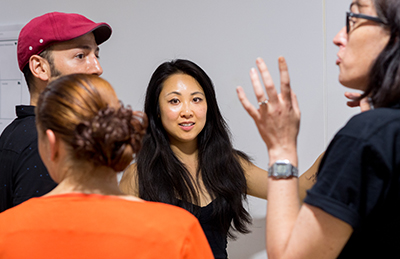NIDA is copresenting an introductory workshop to human-centered design, a problem-solving approach that begins with building empathy and ends with designing innovative new product solutions. Hosted at our NIDA Melbourne studios in Southbank, it features NIDA tutors with Rahul Soans, Founder and Director of the Disruptive Business Network.

![]()
Photo: Human-centered design at NIDAnights: the process begins with empathy
Small business entrepreneurs are part of the backbone of the Australian economy, launching new products and services to drive not just their own businesses but their dream lifestyles. Thousands take out start-up loans and launch websites, only to discover that the ideal of being their own boss is not the paradise they first dreamed of.
Rahul Soans, Founder and Director of the Disruptive Business Network, says that entrepreneurs need to turn their business thinking upside down. He is collaborating with NIDA tutors in Melbourne to present a workshop that explores concepts of human-centered design in business models and product design. NIDAnights: Human-Centered Design 101 is on 17 January at 6.30pm at NIDA Melbourne on Southbank.
‘Human-centered design and the related lean start-up method are not new – but they are concepts that have been credited with igniting up a whole new entrepreneurial economy,’ said Rahul. ‘Traditionally, new products and businesses are built by a waterfall method – where you take an idea, then you look for money for your idea, then you build your product and then you put it out there and fingers crossed, something happens.’
‘Human-centered design is a technique that was popularized by first looking at what people need before you begin to develop your product. Starting at the initial concept phase, it’s about picking the customer group you want to build for and identify what they need, looking at their behavior patterns. From that data you build a prototype, put that in front of them and see how they interact with it.’
‘I often think of the architect Frank Gehry, who would first present a shock vision to his client, then remain in what he called a state of ‘fluidity’, before coming to a place where both he and the client would be happy.’
Rahul admits that human-centered design concepts have come in for a lot of criticism. ‘Lean start-up methodology is criticised for not being “world changing”. But very few of us are developing products like Steve Jobs did or launching rockets at NASA,’ said Rahul. ‘This method is as powerful as it is humbling. It requires you to realise that your “great idea” might be completely wrong!’
‘I have a good example of that myself. I run the Disruptive Business Network and we organised an event with a high profile speaker. I was sure it was going to be sell out event of at least 200 tickets but we only sold 35. Basically I didn’t do enough testing or talking to people. That was humbling for me. Sure for the 35 people who were there it was great. But it was a huge financial loss and embarrassing for me.’
‘With the lean start-up method, you find out who your customers are first and you do that by asking questions. This could be using surveys or interviews, seeing how people react to scenarios. Then you see if you can build a business model around that.’
NIDA Corporate is the centre for acting training for people in business. It provides courses for employees and managers to improve their presentation, communication and networking skills.
‘A lot of product designers and programmers don’t have the skills or the bravado to talk to people,’ said Rahul. ‘That is a skill that is lacking in the product developmental space and is where an organisation like NIDA can help, as it is about breaking down barriers to communication.’
Human-centered design sits at the intersection of creativity and empathy. Empathy is a vital part of acting and it’s also a new buzzword in business circles. How important is empathy in the human-centered design process? ‘That’s a really good question,’ said Rahul. ‘Empathy is hugely important. To really get to know your customer you need to put yourself in their shoes. Without that intuition you find yourself lacking in the design process.’
NIDAnights: Human-Centered Design 101.
17 January 2018, 6.30pm
NIDA Melbourne | Suite 4 | 152 Sturt Street, Southbank, VIC 3006
Price: $30
Tickets are available online or at the door. More informationhere.

